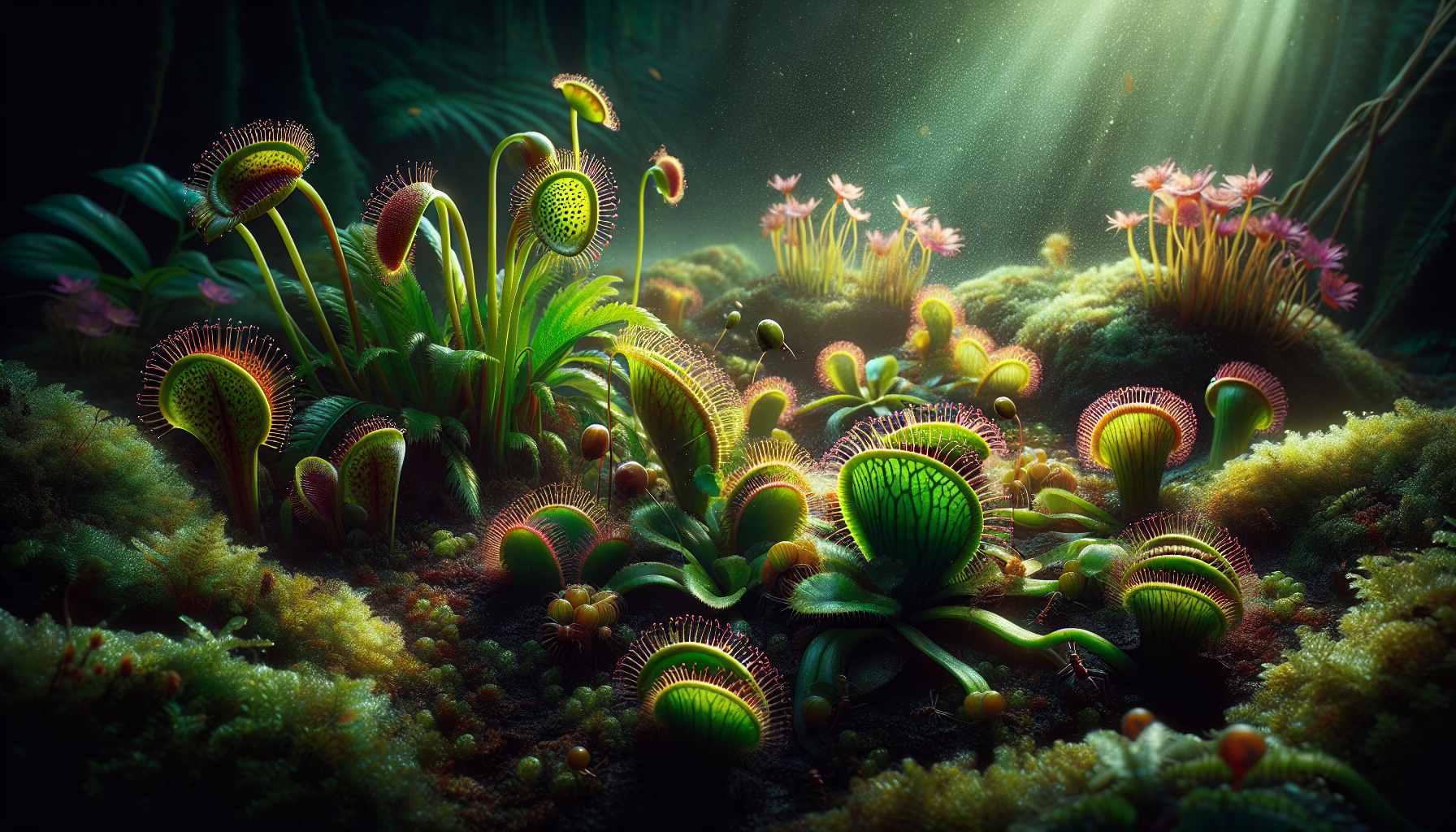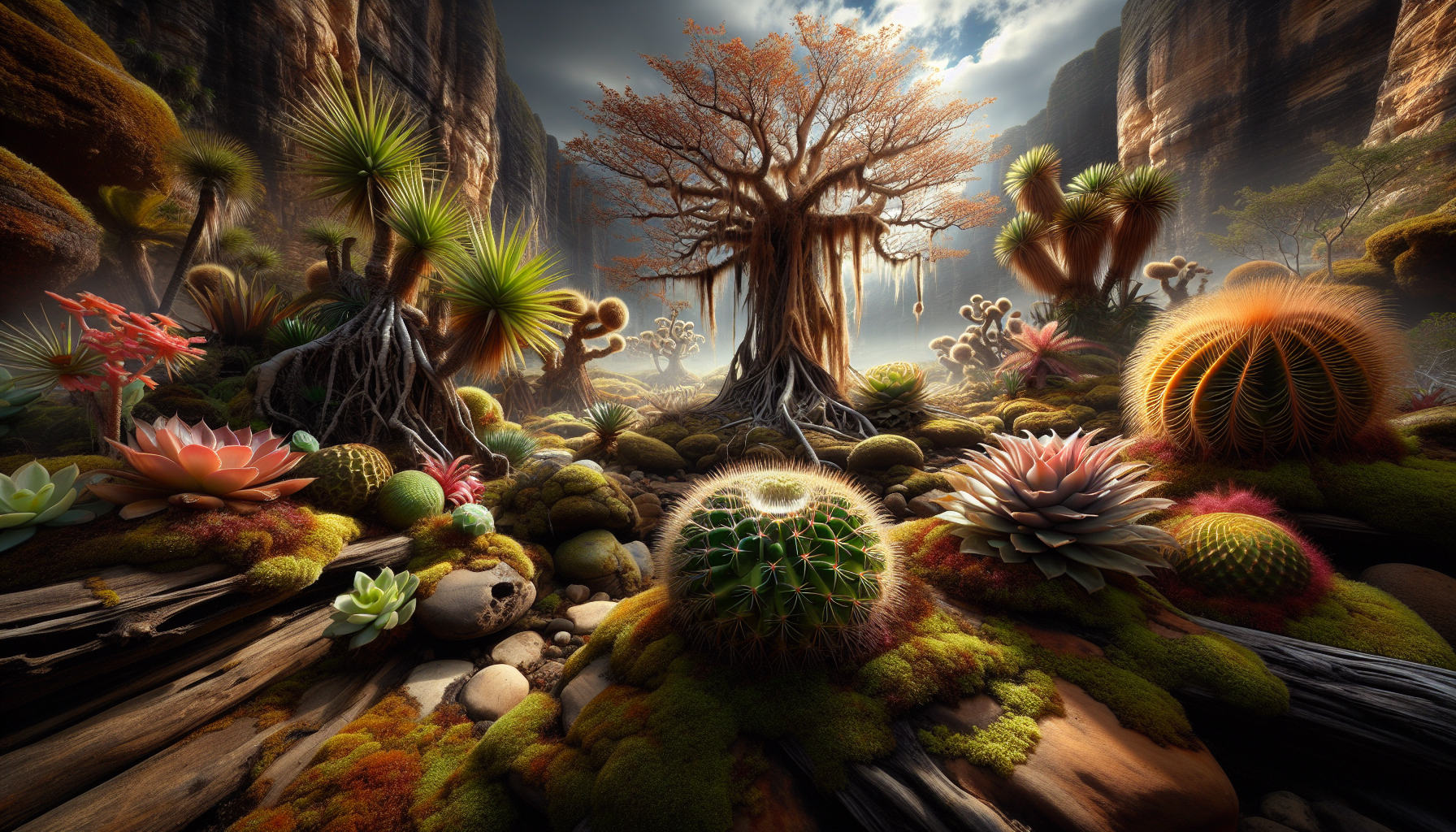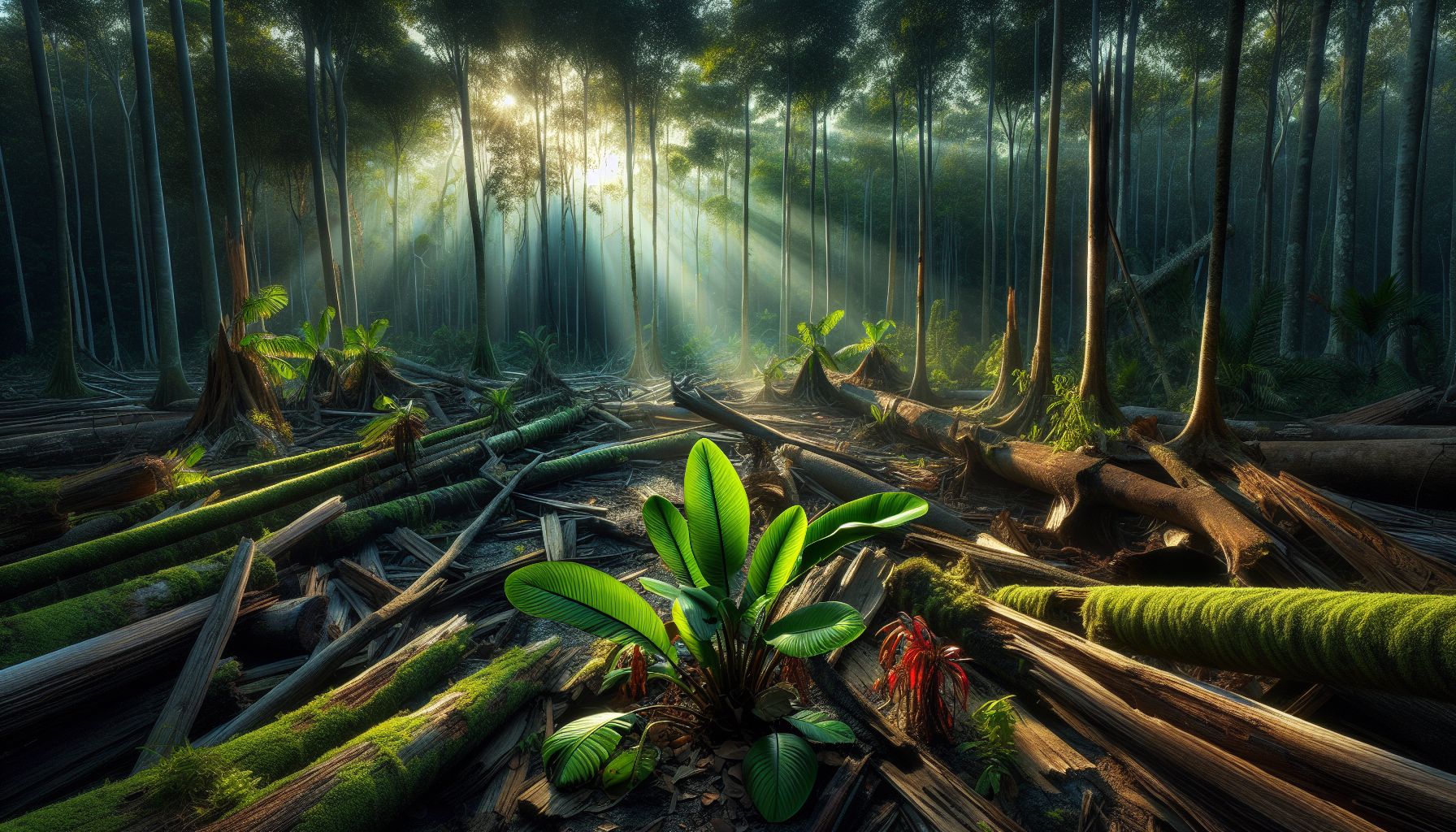In the hidden corners of our natural world, there exists a captivating realm that defies the ordinary. A world where the lush green foliage dances to the tune of nature’s most intriguing orchestra—the insect-eating plants. Imagine a garden where flora becomes fauna, where delicate leaves transform into voracious hunters, and where the soil beneath our feet holds the secrets to a thriving ecosystem that seems plucked from the pages of a fantasy novel. Welcome to the mesmerizing domain of carnivorous plants, where the soil’s unseen magic plays a crucial role in sustaining life. 🌿
The allure of insect-eating plants lies not just in their exotic beauty but in their remarkable adaptations and survival strategies. For centuries, these botanical wonders have fascinated botanists, gardeners, and curious minds alike. Yet, behind their enchanting appearance and predatory prowess, there lies an essential element often overlooked—the soil. Understanding the intricate requirements of the soil that nurtures these plants is akin to unlocking a well-guarded treasure chest, filled with knowledge that can transform the way we cultivate and appreciate these fascinating organisms.
In this comprehensive exploration, we will delve deep into the fundamental secrets of soil that are pivotal for the flourishing of insect-eating plants. From the unique nutritional needs and pH balance to the ideal moisture levels and the role of microorganisms, each aspect of soil composition holds the key to the vitality of these extraordinary plants. We will unravel the mysteries behind why some soils foster growth and others hinder it, offering practical insights and scientific explanations to empower you with the knowledge needed to create your own thriving carnivorous plant haven.
As we embark on this journey, we will traverse the diverse habitats of insect-eating plants, from the misty bogs and swamps to the arid deserts and tropical rainforests, examining how these environments shape the soil’s characteristics and, consequently, the plants’ survival strategies. Whether you are a seasoned horticulturist or a novice gardener, understanding these soil secrets will enhance your ability to cultivate and appreciate the remarkable world of carnivorous plants. So, prepare to dig deep and uncover the rich tapestry of life beneath our feet—where science meets wonder, and the ordinary transforms into the extraordinary. 🌍
Understanding the Unique Environment of Insect-Eating Plants
Insect-eating plants, also known as carnivorous plants, have fascinated botanists and plant enthusiasts alike for centuries. These intriguing plants have developed unique adaptations that allow them to thrive in nutrient-poor environments where other plants would struggle to survive. By understanding the specific conditions these plants require, we can create optimal settings for their growth and maintenance, which is especially crucial for those who cultivate them at home or in controlled environments.
The environment in which insect-eating plants naturally occur is typically harsh and devoid of many of the nutrients essential for plant growth. Most carnivorous plants are found in bogs, wetlands, or other areas with acidic and nutrient-poor soil. These environments provide just enough sustenance to allow these plants to thrive by supplementing their nutrient intake through the digestion of insects and other small organisms. The lack of nitrogen in their native soil is a primary factor that has driven the evolution of their carnivorous habits.
To successfully grow insect-eating plants, it is crucial to mimic their natural habitat as closely as possible. This includes not only replicating the soil conditions but also ensuring the right levels of humidity, light, and water. The key is to balance these factors to create a stable environment that supports their unique nutritional needs. By delving into each of these requirements, we can better appreciate the complexity and beauty of these plants and foster their growth effectively.
Table: Common Types of Insect-Eating Plants and Their Native Environments
| Plant Type | Native Environment | Special Requirements |
|---|---|---|
| Venus Flytrap | Bogs of the Carolinas | High humidity, full sunlight |
| Pitcher Plant | Swamps and marshes | Acidic soil, filtered sunlight |
| Sundew | Wetlands and bogs | High humidity, bright light |
🔍 For a more visual understanding, watch this informative video on YouTube by the channel “Nature’s Secrets”.
Soil Composition: The Foundation of Success
The soil is one of the most critical components for the successful growth of insect-eating plants. These plants typically thrive in poor, acidic soils with low nutrient levels. In their natural habitats, the soil is often composed of peat moss, sand, and sometimes perlite or volcanic rock. This composition allows for excellent drainage while retaining the necessary moisture, creating an environment where the roots of these plants can expand without rotting.
To replicate these conditions, gardeners should aim to create a soil mixture that is low in nutrients but high in moisture retention and aeration. A common homemade mix for many carnivorous plants consists of equal parts peat moss and sand. Peat moss is acidic and helps retain water, while sand improves drainage. Some growers also add perlite or orchid bark to enhance the soil structure and prevent compaction. Avoid using traditional potting soil, as it often contains fertilizers that can harm these plants.
Moreover, it is essential to ensure that the soil remains free of added nutrients, as fertilizers can be detrimental to insect-eating plants. These plants have evolved to obtain nutrients primarily from their prey, and introducing fertilizers can lead to root burn and poor health. The key is to maintain a delicate balance where the soil provides the right acidity and moisture without contributing additional nutrients. By focusing on soil composition and maintenance, enthusiasts can create a thriving environment for these fascinating plants.
The Role of Light and Water in Plant Health
Light and water are two of the most vital factors affecting the growth and health of insect-eating plants. These plants generally require bright, indirect light to thrive, although specific needs can vary depending on the species. For instance, Venus Flytraps and Sundews prefer full sunlight, while some Pitcher Plants may benefit from slightly filtered light. Providing the correct amount of light is essential for photosynthesis, which fuels plant growth and development.
Watering practices are equally critical, as most carnivorous plants originate from environments with high humidity and abundant water. It is crucial to keep the soil consistently moist but not waterlogged, as standing water can lead to root rot. Distilled or rainwater is preferable, as these plants are sensitive to the minerals and chemicals found in tap water. Regular misting can help maintain the humidity levels these plants need, especially in indoor environments where air conditioning or heating systems may dry the air.
To achieve optimal plant health, it is beneficial to monitor both light exposure and watering practices closely. Using tools like moisture meters and light intensity apps can help gardeners make informed decisions about when to water and how much light to provide. Additionally, considering the natural seasonal changes in light and humidity can guide adjustments in care routines, ensuring these captivating plants continue to flourish in any setting.
Understanding Nutrient Requirements Beyond Soil
While soil provides the structural foundation for insect-eating plants, their primary source of nutrients comes from the insects they trap and digest. This unique adaptation allows them to supplement the limited nutrients available in their native soil. The process of capturing and digesting prey involves specialized structures and enzymes that break down the insect’s body, releasing essential nutrients such as nitrogen, phosphorus, and potassium.
Each type of carnivorous plant has evolved distinct mechanisms for trapping and digesting insects. Venus Flytraps use modified leaves that snap shut when triggered by prey, while Pitcher Plants employ a passive pitfall trap filled with digestive enzymes. Sundews, on the other hand, utilize sticky glandular hairs to ensnare insects. Understanding these mechanisms not only highlights the ingenuity of these plants but also underscores the importance of their dietary needs.
In cultivation, it’s important to occasionally supplement their diet with live or freeze-dried insects to ensure they receive adequate nutrition, especially if grown indoors where natural prey may be scarce. This practice can boost plant growth and vitality, allowing them to develop more robust traps and healthier foliage. By recognizing and catering to the unique nutritional strategies of insect-eating plants, enthusiasts can cultivate a thriving collection that showcases the diversity and adaptability of these remarkable organisms.
Tips for Feeding Insect-Eating Plants
- Use small insects such as fruit flies or gnats, which are easy for the plants to digest.
- Feed only once every few weeks, as overfeeding can stress the plant.
- Ensure insects are small enough to be completely digested to prevent mold growth.
🌿 Experience the beauty of carnivorous plants in action by watching this captivating YouTube video.

Conclusion
Unlocking the Secrets of Soil: Discover the Essential Requirements for Thriving Insect-Eating Plants
In conclusion, our exploration into the fascinating world of insect-eating plants has provided us with a comprehensive understanding of the unique soil requirements necessary for their survival and flourishing. Throughout the article, we have delved into the specific conditions that these extraordinary plants need to thrive, focusing on aspects such as soil composition, acidity, drainage, and nutrient levels.
First and foremost, we discussed the critical role of soil composition in supporting the growth of insect-eating plants. These plants, often referred to as carnivorous plants, have adapted to grow in environments where the soil is poor in nutrients. This characteristic necessitates a specialized soil mixture that mimics their natural habitats. Typically, these soils are composed of ingredients like sphagnum moss, sand, and perlite, which collectively create a low-nutrient, well-draining environment ideal for these plants. Such conditions are crucial for their ability to capture and digest insects, which provide the nutrients that the soil lacks.
Furthermore, we highlighted the importance of soil acidity. Insect-eating plants generally thrive in acidic soils with a pH level ranging from 4.5 to 5.5. This level of acidity helps prevent the growth of bacteria and fungi that could otherwise harm the plants. Additionally, the acidic conditions are conducive to the optimal functioning of the plants’ digestive enzymes, which are vital for breaking down the prey they capture. Ensuring the soil maintains this level of acidity is paramount for the health and vitality of these plants.
Drainage is another essential factor we explored. Carnivorous plants require soils that allow excess water to drain away quickly to prevent root rot, which can be detrimental to their health. This is why the inclusion of materials such as sand and perlite is so important—they enhance the soil’s drainage capabilities, allowing these plants to retain the moisture they need without becoming waterlogged.
Moreover, we discussed the necessity of maintaining appropriate moisture levels in the soil. While insect-eating plants need well-drained soils, they also require consistent moisture to thrive. Striking the right balance between drainage and moisture retention is key to creating an environment that mimics their natural boggy habitats, where they can absorb water and nutrients effectively.
As we conclude, it is evident that understanding and meeting the soil requirements of insect-eating plants is essential for their successful cultivation. These fascinating plants are not just intriguing for their unique feeding habits but also serve as a reminder of the delicate balance of ecosystems and the wonders of adaptation in the plant kingdom.
The importance of this topic extends beyond just gardening enthusiasts and plant lovers. It highlights the broader ecological significance of preserving diverse habitats and understanding plant adaptations. By cultivating these plants and sharing knowledge about their care, we contribute to the conservation of biodiversity and the protection of unique plant species that play a vital role in their ecosystems.
We encourage you, our readers, to apply what you have learned and explore the captivating world of insect-eating plants. Whether you are a seasoned gardener or a curious beginner, embracing the challenge of growing these plants can be a rewarding experience. Moreover, sharing this knowledge with others and encouraging them to appreciate the beauty and complexity of these plants can inspire a greater appreciation for the natural world.
Feel free to leave your comments and share your experiences with growing insect-eating plants. Let’s create a community of plant enthusiasts who learn from each other and foster a deeper understanding of these remarkable organisms. Share this article with your friends and family to spread awareness and appreciation for the intricate requirements of these plants and the marvels of nature they represent. 🌱
For further reading and research, you may explore resources from trusted horticultural websites or botanical gardens. Here are a few active links to guide your exploration:
3. The International Carnivorous Plant Society
These sources offer a wealth of information and insights into the world of carnivorous plants, providing you with the tools to cultivate these unique species successfully. Happy gardening! 🌿
Toni Santos is a visual storyteller and botanical artisan whose creations explore the wild elegance of carnivorous and exotic plants. With a deep reverence for nature’s most mysterious flora, Toni captures the untamed beauty of insect-eating mechanisms, alien-like blooms, and resilient life thriving in extreme environments.
Rooted in a lifelong fascination with the strange intelligence of plants, his work blends science, symbolism, and storytelling. From the snap of a Venus flytrap to the labyrinthine curves of a Nepenthes pitcher, each piece Toni creates reveals a deeper narrative — one of survival, adaptation, and the subtle power of nature’s most unexpected designs.
With a background in visual design and handcrafted artistry, Toni merges technique with intention, crafting illustrations, collections, and visual studies that not only depict these botanical wonders — but evoke their hidden magic. His inspiration often comes from ancient lore, natural history, and the eerie elegance of ecosystems where these plants thrive.
As the creative force behind Vizovex, Toni shares this botanical fascination with the world, offering curated artwork, stories, and pieces that help others reconnect with nature’s wilder, more enigmatic side.
His work is a tribute to:
The fierce beauty of carnivorous plants
The visual language of adaptation and survival
The mysteries of exotic flora in forgotten habitats
Whether you’re a plant enthusiast, a science lover, or someone drawn to the strange and beautiful, Toni welcomes you into a world where every leaf hides a secret — one trap, one tendril, one story at a time.





